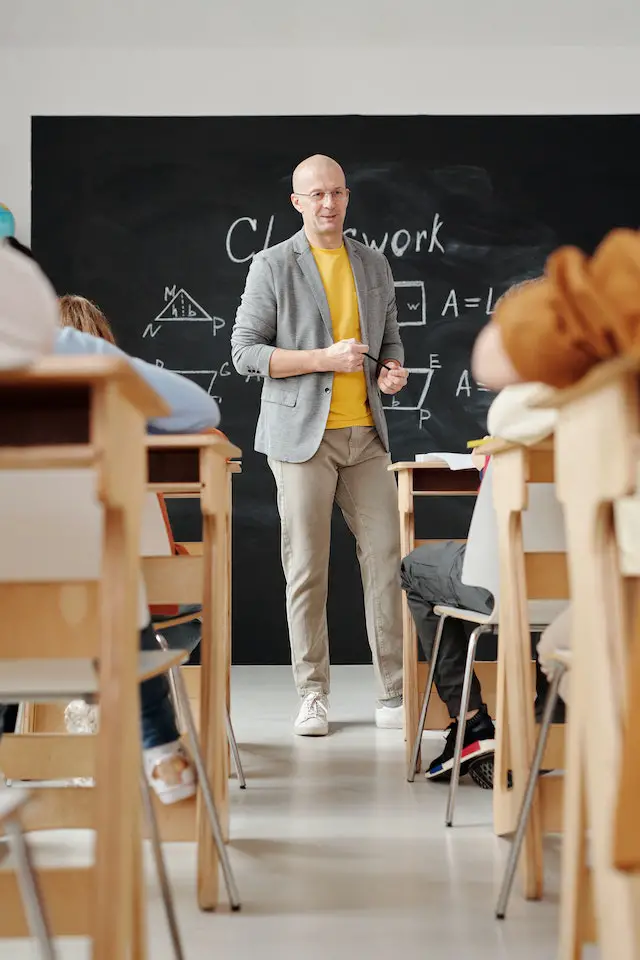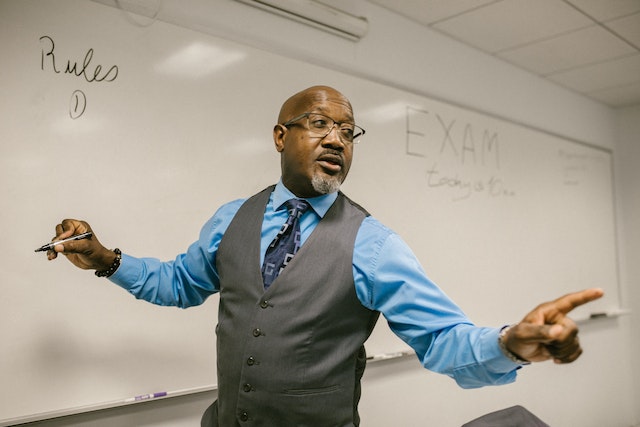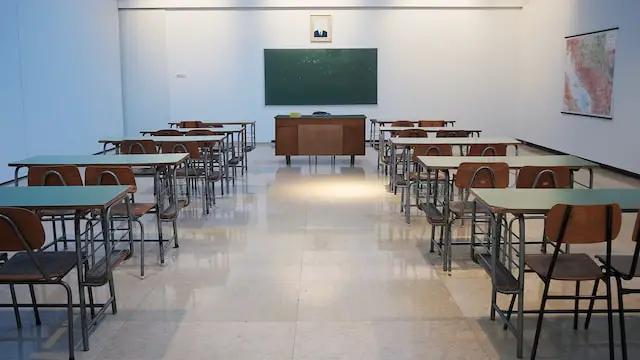Essentialism emphasizes traditional teaching and core knowledge, while progressivism focuses on student-centered, experiential learning and adaptability.
What is Essentialism?

Essentialism is an educational philosophy that emphasizes the importance of core knowledge and academic rigor. It focuses on transmitting essential knowledge, skills, and values to students. Here are some key characteristics of essentialism:
- Subject-Centered: Essentialism places a strong emphasis on traditional academic subjects, such as mathematics, science, history, and literature.
- Teacher-Directed: In essentialism, the teacher takes on a central role as the authority figure, imparting knowledge and maintaining discipline in the classroom.
- Standardized Curriculum: Essentialist education follows a standardized curriculum, ensuring that all students receive a similar educational experience and cover essential content.
- Structured and Disciplined: The classroom environment in essentialism is structured, disciplined, and focused on academic achievement.
- Emphasis on Core Knowledge: Essentialism prioritizes the mastery of core knowledge and foundational skills that are considered essential for a well-rounded education.
Core Principles of Essentialism
Incorporating the core principles of essentialism, Mrs. Johnson, in a classroom following this educational philosophy, noticed that her students were facing difficulties in understanding basic math concepts. To address this, she decided to take a step back and concentrate on establishing a strong foundation for her students. Mrs. Johnson developed a comprehensive math curriculum that focused on essential skills and concepts. Through direct instruction and guided practice, she imparted important math principles like addition and subtraction. By adopting a patient and structured approach, the students gradually developed a solid understanding of these fundamental math concepts. Consequently, their confidence grew, enabling them to apply their knowledge to more complex mathematical problems. Mrs. Johnson’s adherence to the core principles of essentialism ensured that her students acquired the necessary skills to succeed academically and personally.
Traditional Teaching Methods
Traditional teaching methods serve as a crucial component of the educational philosophy of essentialism. These methods place a high priority on discipline, order, and a structured learning environment. In the context of traditional teaching methods, the teacher holds the position of the main authority figure in the classroom and possesses the knowledge that they impart to the students.
Direct instruction is a commonly used traditional teaching method, in which the teacher imparts information through lectures, demonstrations, and explicit teaching. This approach is characterized by its teacher-centered nature, where students passively receive knowledge.
Another prevalent traditional teaching method is rote learning, which involves the repetition and memorization of facts and information. This method concentrates on the mastery of fundamental skills and knowledge, such as multiplication tables or grammar rules.
In addition to this, traditional teaching methods encompass the use of textbooks, written assignments, and exams to evaluate student learning. These methods prioritize instruction based on content and usually adhere to a standardized curriculum.
Although traditional teaching methods provide structure and discipline, they may not offer sufficient opportunities for student engagement, critical thinking, and problem-solving. Therefore, it is essential for educators to strike a balance between traditional teaching methods and more progressive approaches in order to cater to the diverse needs of students.
To enrich traditional teaching methods, educators can incorporate student-centered activities, collaborative learning, and the integration of technology. These strategies can contribute to fostering a more dynamic and captivating learning environment while still reaping the benefits of traditional teaching methods.
Traditional teaching methods play a vital role in essentialism, emphasizing the importance of structure, order, and the teacher’s role as the primary authority. By integrating elements from progressive approaches, educators can establish a more well-rounded and effective educational experience for students.
Emphasis on Standardized Curriculum
The emphasis on standardized curriculum in education plays a crucial role in ensuring consistency and objective assessment. In this approach, a standardized curriculum is designed to provide a uniform set of knowledge and skills to all students. This entails clearly defined learning objectives, topics, and assessment criteria that are consistent across schools and districts.
The standardized curriculum allows for easier evaluation of student performance as it provides a clear benchmark for assessing knowledge and skills. It ensures that all students are exposed to similar content, which helps maintain a level playing field. It enables educational institutions to identify gaps in learning and develop targeted interventions to address them.
By prioritizing an emphasis on standardized curriculum, education systems aim to prepare students for standardized tests and college entrance examinations. These assessments often require a comprehensive understanding of specific subjects, and a standardized curriculum ensures that students are equipped with the necessary knowledge and skills to succeed in these exams.
While acknowledging the importance of the emphasis on standardized curriculum, it is vital to strike a balance with individualized and student-centered approaches to education. This allows for the recognition of diverse learning styles and interests and promotes critical thinking and creativity. By integrating elements of both standardized and personalized approaches, education can cater to the needs of all students while maintaining a consistent and rigorous curriculum.
What is Progressivism?

Progressivism, on the other hand, is an educational philosophy that emphasizes student-centered learning, experiential learning, and social development. It focuses on engaging students in active learning experiences. Here are some key characteristics of progressivism:
- Student-Centered: Progressivism places the student at the center of the learning process, valuing their interests, experiences, and individual needs.
- Experiential Learning: Progressivist education emphasizes hands-on, experiential learning, where students learn through real-life experiences, problem-solving, and collaboration.
- Flexible Curriculum: Progressivism promotes a flexible curriculum that allows for student interests and incorporates real-world issues and current events.
- Democratic Classroom: The classroom environment in progressivism encourages student participation, critical thinking, and active engagement. Students are encouraged to voice their opinions and contribute to decision-making.
- Holistic Development: Progressivism emphasizes the holistic development of students, including their social, emotional, and cognitive growth.
Understanding the differences between essentialism and progressivism can help educators and policymakers make informed decisions about educational practices and curriculum design, ensuring a well-rounded approach to teaching and learning.
Core Principles of Progressivism
Progressivism in education is guided by several core principles, which form the foundation of this educational philosophy and shape the approach to teaching and learning. The core principles of progressivism, known as the “Core Principles of Progressivism,” include active learning, experiential learning, and student-centered learning.
Active learning is one of the fundamental core principles of progressivism. It emphasizes the significance of engaging students in hands-on activities and experiences. Rather than simply receiving information from teachers, students are encouraged to actively participate in their own learning.
Experiential learning is another key core principle of progressivism. It acknowledges that students learn best through direct experiences and interactions with the world around them. To implement this principle, real-life experiences, field trips, and project-based learning are all integrated into the progressivist approach.
Student-centered learning is also a crucial principle of progressivism. It highlights the importance of tailoring education to meet the unique needs and interests of individual students. Progressivist educators firmly believe that students should have a say in what and how they learn, allowing for greater autonomy and personalization in the learning process.
By adhering to these “Core Principles of Progressivism,” progressive educators strive to create an engaging and meaningful learning experience for students. They prioritize active, experiential, and student-centered approaches to education, cultivating a love for learning and equipping students with the necessary skills to tackle future challenges.
Focus on Experiential Learning
The focus on experiential learning is a central aspect of the progressivism educational philosophy. In this approach, students are actively engaged in their learning experiences, allowing them to gain knowledge through firsthand exploration and application.
Instead of simply listening to lectures or reading textbooks, students are encouraged to participate in hands-on activities, experiments, and real-world projects. This approach helps them develop critical thinking skills, problem-solving abilities, and a deeper understanding of the subject matter.
Experiential learning also promotes student engagement and motivation. By immersing themselves in practical experiences, students become active participants in their own education, making connections between theory and practice.
In progressive classrooms, teachers act as guides or facilitators, providing guidance and support rather than delivering information. They encourage students to ask questions, pursue their interests, and explore topics in depth. This fosters a love for learning and helps students develop skills that are applicable in real life.
The focus on experiential learning in progressivism enhances students’ ability to apply knowledge, think critically, and develop a lifelong love for learning.
One significant example of experiential learning in history is the Lewis and Clark Expedition. In the early 1800s, Meriwether Lewis and William Clark embarked on an exploration journey across the western territories of the United States. Rather than simply reading about the land and its native inhabitants, they engaged in firsthand experiences and documented their findings.
Through their exploratory journey, Lewis and Clark encountered various challenges and learned practical skills such as navigation, mapmaking, and survival techniques. They also interacted with Native American tribes, exchanging knowledge and gaining insight into different cultures.
The Lewis and Clark Expedition exemplifies how experiential learning can not only expand knowledge but also contribute to personal growth and a deeper understanding of the world.
Student-Centered Learning Approaches
- Students engage in group projects where they actively participate in decision-making and problem-solving. This approach enhances critical thinking and communication skills.
- Students learn by doing, participating in real-life simulations, experiments, and field trips. This approach fosters active engagement and application of knowledge.
- Teachers tailor instruction to meet the unique learning needs and interests of each student. This approach promotes self-paced learning and a deep understanding of the material.
- Students learn from and with their peers through discussions, debates, and student-led presentations. This approach promotes collaboration, empathy, and a sense of community.
- Teachers provide timely and specific feedback to guide students’ learning progress. This approach empowers students to take ownership of their learning and make continuous improvements.
Pro-tip: When implementing student-centered learning approaches, it is essential to create a supportive and inclusive classroom environment. Encourage open communication, respect diverse perspectives, and provide scaffolding to help students develop autonomy and self-motivation.
Key Differences Between Essentialism and Progressivism
Goals of Education
In education, the goals of education vary depending on the educational philosophy being followed, whether it’s essentialism or progressivism.
1. Essentialism:
- The primary objective of education in essentialism is to provide students with a solid foundation of knowledge and essential skills.
- Essentialists firmly believe that education should prioritize the development of students’ intellectual abilities and their readiness for the workforce.
- The emphasis is on academic subjects, such as mathematics, science, and language arts, to ensure students acquire a broad base of knowledge.
2. Progressivism:
- The main goal of education in progressivism is to nurture the growth of well-rounded individuals who can think critically and make meaningful contributions to society.
- Progressivists advocate for a more holistic approach that concentrates on the social and emotional development of students.
- The aim is to engage students in relevant learning experiences that are both meaningful and connected to their interests and real-world problems.
It is important to note that both educational philosophies have different goals but can be integrated to create a balanced approach. For example, essentialism’s focus on core knowledge can be enriched by incorporating progressive elements such as experiential learning and student-centered approaches.
To determine which educational philosophy is right for you, consider your own beliefs about education and the needs of the students you are teaching. Ultimately, the goals of education should align with the desired outcomes and objectives you have for your students.
Teacher’s Role
In the educational philosophies of Essentialism and Progressivism, the role of the teacher is crucial in shaping the learning environment and facilitating student growth and development. The teacher’s role in Essentialism is that of an authority figure and expert in their subject matter, responsible for imparting knowledge and essential skills to students. They follow a structured curriculum and employ traditional teaching methods such as lecturing and direct instruction.
In contrast, in Progressivism, the role of the teacher is more that of a facilitator and guide. They create a student-centered learning environment that promotes active participation, critical thinking, and problem-solving skills. They encourage experiential learning where students learn through hands-on activities, discussions, and collaboration.
The teacher in both philosophies plays a pivotal role in fostering a positive learning environment, nurturing students’ intellectual and social growth, and providing support and guidance. The emphasis on the teacher’s role differs. Essentialism places a greater emphasis on the teacher as the source of knowledge, while Progressivism focuses on the teacher as a facilitator of learning experiences.
Ultimately, finding the right balance between Essentialist and Progressive elements in the teacher’s role can maximize student engagement and promote a well-rounded education. The teacher should adapt their approach to meet the unique needs and learning styles of their students, cultivating their curiosity, creativity, and critical thinking skills.
Curriculum and Instructional Methods
When comparing Essentialism and Progressivism in terms of curriculum and instructional methods, it is important to consider their differences in approach and focus.
| Essentialism | Progressivism |
|---|---|
| Curriculum: | Curriculum: |
| – Emphasizes a core set of essential knowledge and skills. | – Prioritizes real-world experiences and hands-on learning. |
| – Curriculum is standardized and focuses on traditional subject areas such as math, science, and language arts. | – Curriculum is flexible and relates to students’ interests, needs, and experiences. |
| Instructional Methods: | Instructional Methods: |
| – Teacher-centered approach with a focus on direct instruction. | – Student-centered approach with a focus on collaborative and inquiry-based learning. |
| – Emphasizes discipline and order in the classroom. | – Encourages creativity, critical thinking, and active student participation. |
| – Instruction is structured, following a predetermined plan. | – Instruction is flexible, allowing for exploration and adaptation based on student interests and needs. |
Both educational philosophies have their own advantages and disadvantages when it comes to curriculum and instructional methods. Essentialism provides a structured and systematic approach that ensures students receive a solid foundation of essential knowledge and skills. On the other hand, Progressivism promotes a more student-centered approach that allows for personalized learning and fosters creativity and critical thinking.
Ultimately, the choice between Essentialism and Progressivism in terms of curriculum and instructional methods depends on the goals and preferences of the educators and the needs of the students.
Assessment and Evaluation
Assessment and evaluation are crucial components of the educational process. They provide valuable insights into students’ progress and understanding. Here is a table that highlights the key aspects of assessment and evaluation in the context of essentialism and progressivism.
| Aspect | Essentialism | Progressivism |
| Focus | Emphasizes standardized tests and assessments to measure student achievement. | Values ongoing, authentic assessments that reflect real-world applications and students’ individual growth. |
| Goal | To determine the extent to which students have acquired the essential knowledge and skills outlined in the standardized curriculum. | To assess students’ ability to apply their learning to solve complex problems and think critically. |
| Methods | Utilizes traditional assessment methods such as quizzes, exams, and standardized tests. | Encourages a variety of assessment methods, including projects, presentations, portfolios, and collaborative work. |
| Feedback | Primarily focuses on grades and scores as indicators of student achievement. | Values providing constructive feedback to support students’ growth and development. |
| Individualization | Assessment and evaluation are often standardized, allowing for comparisons across students. | Recognizes the uniqueness of every student and tailors assessments to their individual needs and strengths. |
Understanding the approach to assessment and evaluation within each educational philosophy is essential in designing effective learning experiences. Finding a balance between the two by incorporating elements of both essentialism and progressivism can provide a comprehensive educational experience. It is important to consider the goals of education, student needs, and the desired outcomes when determining the best assessment and evaluation methods to utilize.
Finding Balance: Integrating Essentialist and Progressive Elements
Integrating essentialist and progressive elements can lead to a balanced approach in various areas. Here’s how to find that balance:
- Educational Philosophy: In the field of education, integrating essentialist elements, such as a focus on core knowledge and traditional teaching methods, with progressive elements, such as student-centered learning and critical thinking, can create a well-rounded educational experience.
- Workplace Culture: Balancing essentialist elements like structure, organization, and clear roles with progressive elements like flexibility, innovation, and collaborative decision-making can foster a productive and dynamic workplace culture.
- Personal Development: Integrating essentialist principles, such as setting clear goals and prioritizing tasks, with progressive elements like embracing change, seeking new experiences, and adapting to challenges, can support personal growth and success.
- Parenting Styles: Combining essentialist elements like establishing routines, instilling values, and setting boundaries with progressive elements like encouraging independence, promoting open communication, and supporting personal expression can create a nurturing and empowering parenting approach.
- Social and Political Issues: Finding a balance between essentialist values like tradition and stability and progressive values like equality and social justice can contribute to a society that respects its history while striving for positive change.
- Health and Wellness: Integrating essentialist elements like maintaining a balanced diet, regular exercise, and sufficient rest with progressive elements like exploring alternative therapies, practicing mindfulness, and prioritizing mental well-being can promote holistic health.
By integrating essentialist and progressive elements in these areas and others, individuals and communities can embrace the benefits of both approaches, achieving a harmonious balance that combines tradition with innovation, stability with growth, and structure with adaptability.
Which Educational Philosophy is Right for You?
Choosing the right educational philosophy that aligns with your beliefs and goals is essential. Consider these factors to determine whether essentialism or progressivism is the right approach for you:
- Focus on Knowledge: Essentialism emphasizes a rigorous curriculum with a focus on core subjects and essential knowledge. If you believe in a structured and content-focused education, essentialism may be the right choice.
- Student-Centered Learning: Progressivism, on the other hand, emphasizes a student-centered approach where students actively participate in their learning process. If you believe in fostering creativity, critical thinking, and student autonomy, progressivism may be the right fit.
- Teacher’s Role: Essentialism sees the teacher as an authority figure who imparts knowledge and directs the learning process. Progressivism views the teacher as a facilitator who guides and supports students in their exploration and discovery.
- Curriculum: Essentialism follows a standardized curriculum based on traditional subjects and academic standards. Progressivism promotes a flexible curriculum that adapts to students’ interests, needs, and real-world contexts.
- Evaluation: Essentialism leans towards traditional assessments such as exams and grades to measure students’ progress. Progressivism emphasizes alternative assessments like projects, portfolios, and hands-on demonstrations to evaluate students’ understanding and skills.
- Social Development: Essentialism focuses on preparing students to be responsible members of society through instilling values, discipline, and respect for authority. Progressivism emphasizes social interaction and collaborative learning, fostering empathy, and encouraging students to engage with diverse perspectives.
- Personalized Learning: If you believe in individualized instruction and tailoring education to students’ unique needs, progressivism may be more suitable. Essentialism, on the other hand, emphasizes a standardized approach for all students.
- Real-World Application: Progressivism emphasizes hands-on experiences and connecting learning to real-world situations. Essentialism focuses on acquiring foundational knowledge that can be applied to various contexts.
- Education Philosophy: Consider your own educational philosophy, values, and teaching style. Reflect on whether you lean towards a more traditional, structured approach (essentialism) or a more student-centered, experiential approach (progressivism).
By considering these factors, you can make an informed decision about which educational philosophy, essentialism or progressivism, aligns best with your values, teaching style, and desired learning outcomes.
Frequently Asked Questions
What is the difference between essentialism and progressivism in education?
Essentialism and progressivism are two different educational theories that have distinct approaches. Essentialism focuses on accountability and meeting standards, while progressivism is child-centered and encourages active learning. Essentialism uses high stakes tests to assess students, while progressivism emphasizes hands-on learning through real-life activities. Both theories aim for student success but have different philosophies on how to achieve it.
How do essentialism and progressivism differ in terms of curriculum development?
Essentialism prioritizes teaching the basics and preparing students for the real world. It emphasizes academic skills and vocational training, with a focus on standardized testing and meeting standards. Progressivism, on the other hand, aims to prepare students for all aspects of life by engaging them in real-life activities. It emphasizes a more flexible and modern view of education, moving away from traditional classroom setups.
What are the evaluation techniques used in essentialism and progressivism?
Essentialism relies heavily on high stakes tests to assess students’ knowledge and skills. The emphasis is on standardized testing and meeting specific standards. Progressivism, on the other hand, emphasizes a more holistic approach to evaluation. It focuses on assessing students through hands-on activities and real-life projects, rather than solely relying on standardized tests.
How do essentialism and progressivism differ in their views on classroom management?
Essentialism follows a more conservative theory of education, with rigid teaching and testing methods. It often involves teachers standing at the front of the classroom while students passively listen. In contrast, progressivism sees students as active learners who need to participate in their own education. It advocates for a more student-centered approach, with a focus on engagement and interaction.
What are the main differences between essentialism and progressivism in terms of their philosophical theories?
Essentialism has its roots in more conservative and traditional philosophies, such as those of Rene Descartes and Immanuel Kant. It emphasizes the importance of basic skills and intellectual training. Progressivism, on the other hand, draws inspiration from philosophers like John Dewey and Josiah Royce. It promotes a more liberal and forward-thinking approach, emphasizing hands-on learning and the preparation of students for the present generation.
Is it possible to find a healthy combination of essentialism and progressivism in education?
Yes, it is possible to find a balance between essentialism and progressivism in education. A combination of both theories can be beneficial. By incorporating the focus on basic academic skills from essentialism and the hands-on learning and engagement from progressivism, educators can create a more well-rounded and comprehensive educational approach that prepares students for life after school.
Image Credits
Featured Image By – Ivan Aleksic on Unsplash
Image 1 By – Photo by Max Fischer:
Image 2 By – Photo by RDNE Stock project








